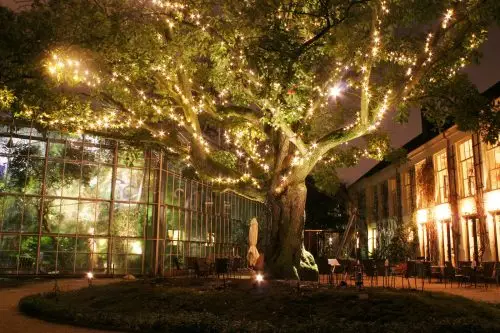🎇𝗛𝗮𝗽𝗽𝘆 𝗡𝗲𝘄 𝗬𝗲𝗮𝗿 𝘁𝗼 𝗮𝗹𝗹 𝗳𝗼𝗹𝗹𝗼𝘄𝗲𝗿𝘀, 𝘃𝗶𝘀𝗶𝘁𝗼𝗿𝘀 𝗮𝗻𝗱 𝗛𝗼𝗿𝘁𝘂𝘀 𝗹𝗼𝘃𝗲𝗿𝘀!
💚🌱We wish you a wonderful 2026 filled with love, happiness and of course: plants!
🥰Hopefully see you very soon in our garden.
-
🎇𝗚𝗲𝗹𝘂𝗸𝗸𝗶𝗴 𝗻𝗶𝗲𝘂𝘄𝗷𝗮𝗮𝗿 𝗮𝗮𝗻 𝗮𝗹 𝗼𝗻𝘇𝗲 𝘃𝗼𝗹𝗴𝗲𝗿𝘀, 𝗯𝗲𝘇𝗼𝗲𝗸𝗲𝗿𝘀 𝗲𝗻 𝗛𝗼𝗿𝘁𝘂𝘀 𝙡𝙤𝙫𝙚𝙧𝙨!
💚🌱We wensen je een prachtig 2026 vol met liefde, geluk en natuurlijk: planten!
🥰Hopelijk tot heel snel in onze tuin.

💙What a year it’s been.
🌴2025 was a big one for us at the Hortus - a year of dedication and transformation as we renovated our entire Climate House. As we close the year, we’re incredibly grateful for your patience, encouragement, and continued support throughout the process. Our Climate House is thriving and more beautiful than ever.
💘And also: a big thank you to all our visitors who wandered the paths, admired the plants, and supported us along the way.
✨We’re excited to welcome you back for everything the year ahead will bring!
-
💙Wat een jaar is het geweest.
🌴2025 was een belangrijk jaar voor ons bij Hortus - een jaar van toewijding en transformatie, waarin we onze volledige Klimatenkas hebben gerenoveerd. Nu het jaar ten einde loopt, zijn we ontzettend dankbaar voor jouw geduld, aanmoedigingen en voortdurende steun tijdens het hele proces. Want wat is het mooi geworden.
💘En ook: heel veel dank aan ál onze bezoekers die over de paden hebben gewandeld, de planten hebben bewonderd en ons hebben gesteund.
✨We kijken ernaar uit om je weer te verwelkomen in de tuin in het nieuwe jaar! Wij hebben er zin in!

💚With its remarkable pale green flowers, the 𝗵𝗼𝗹𝗹𝘆-𝗹𝗲𝗮𝘃𝗲𝗱 𝗵𝗲𝗹𝗹𝗲𝗯𝗼𝗿𝗲 (𝘏𝘦𝘭𝘭𝘦𝘣𝘰𝘳𝘶𝘴 𝘢𝘳𝘨𝘶𝘵𝘪𝘧𝘰𝘭𝘪𝘶𝘴) is a perfect addition to the winter garden.
🌿🎄It`s native to Corsica and Sardinia and takes its common name from its sharply toothed, glossy evergreen leaves, which closely resemble those of... holly!
-
💚Deze wintergroene 𝗸𝗲𝗿𝘀𝘁𝗿𝗼𝗼𝘀 (𝘏𝘦𝘭𝘭𝘦𝘣𝘰𝘳𝘶𝘴 𝘢𝘳𝘨𝘶𝘵𝘪𝘧𝘰𝘭𝘪𝘶𝘴) is de perfecte toevoeging in elke wintertuin.
🌿🎄Oorspronkelijk komt de soort uit Corsica en Sardinië. Z`n groene, leerachtige blad doet wel wat denken aan hulst. De naam `argutifolius` betekent `scherpgetand blad`.

✨️Weer een magische Winteravond in de Hortus!
👀En we hebben nog maar vier Winteravonden te gaan, dus koop nu snel je ticket via de link in bio.
👉🏽Onze volgende Winteravonden zijn vandaag (29e), 30 december en 2 & 3 januari.
🍷De tuin en kassen zijn geopend tot 19:00 uur, met een kampvuur op ons terras en natuurlijk glühwein en warme choco.
Vanaf 16:30 uur is de toegangsprijs verlaagd naar 7 euro.
-
✨️Another magical Winter Evening in the Hortus!
👀And with only four more to go, we suggest you hurry and get your tickets through the link in bio.
👉🏽Our next Winter Evenings are tonight (29th), December 30 and January 2 & 3.
🍷The garden and greenhouses will be open until 7 p.m., with a campfire on our terrace and, of course, delicious mulled wine and hot chocolate.
From 4.30 p.m. onwards, the admission price will be reduced to 7 euros.

🌴Flowering in our Palm House is this 𝘍𝘶𝘤𝘩𝘴𝘪𝘢 𝘱𝘢𝘯𝘪𝘤𝘶𝘭𝘢𝘵𝘢, native to the cloud forests and mountainous areas of Central America.
💗It has beautiful tall, airy panicles of soft pink to lilac flowers, creating a delicate haze of colour.
-
🌴In onze Palmenkas bloeit deze 𝘍𝘶𝘤𝘩𝘴𝘪𝘢 𝘱𝘢𝘯𝘪𝘤𝘶𝘭𝘢𝘵𝘢, afkomstig uit de nevelbossen en bergachtige gebieden van Midden-Amerika.
💗Hij heeft prachtige hoge, luchtige pluimen met zachtroze tot lila bloemen, die een delicate kleurenwaas creëren.

💜Vanavond is de eerste Hortus Winteravond!
🍷De sfeervol verlichte tuin en kassen zijn geopend tot 19:00 uur, met een kampvuur op ons terras en natuurlijk heerlijke glühwein en warme choco.
❄️Vanaf 16:30 is de toegangsprijs bovendien verlaagd naar 7 euro.
Zien we je straks? Tickets koop je aan de kassa of via de 𝗹𝗶𝗻𝗸 𝗶𝗻 𝗯𝗶𝗼.
📸door Yohannes Henriksson tijdens Museumnacht 2025.
-
💜Tonight is our first Hortus Winter Evening!
🍷The beautifully lit garden and greenhouses will be open until 7 p.m., with a campfire on our terrace and, of course, delicious mulled wine and hot chocolate.
❄️From 4.30 p.m., the admission price will be reduced to 7 euros.
Will we see you in the garden today?
Tickets can be purchased at the ticket office or via the 𝗹𝗶𝗻𝗸 𝗶𝗻 𝗯𝗶𝗼.
📸by Yohannes Henriksson during Museum Night 2025.

This 𝘃𝗲𝗲𝗿𝗸𝗼𝗽𝗽𝗶𝗲 or 𝗳𝗲𝗮𝘁𝗵𝗲𝗿𝗵𝗲𝗮𝗱 (𝘗𝘩𝘺𝘭𝘪𝘤𝘢 𝘱𝘶𝘣𝘦𝘴𝘤𝘦𝘯𝘴) might look dusted with fine snow, but this silvery beauty is right at home in the sun of South Africa’s fynbos.
✨️Its hairy leaves seem to gather the sunlight and make it glow.
-
Dit 𝘃𝗲𝗲𝗿𝗸𝗼𝗽𝗽𝗶𝗲 (𝘗𝘩𝘺𝘭𝘪𝘤𝘢 𝘱𝘶𝘣𝘦𝘴𝘤𝘦𝘯𝘴) lijkt misschien bedekt met fijne sneeuw, maar deze zilverkleurige schoonheid voelt zich helemaal thuis in de zon van het Zuid-Afrikaanse fynbos.
✨️Z`n harige bladeren vangen het zonlicht en laten hem prachtig oplichten.

☃️💖𝗠𝗲𝗿𝗿𝘆 𝗖𝗵𝗿𝗶𝘀𝘁𝗺𝗮𝘀!
👀This Christmas classic - the 𝗺𝗶𝘀𝘁𝗹𝗲𝘁𝗼𝗲 (𝘝𝘪𝘴𝘤𝘶𝘮 𝘢𝘭𝘣𝘶𝘮) - has long been woven into holiday traditions, symbolising peace, love, and connection beneath its evergreen leaves. But in nature, this plant lives a rather dark life...
🧛🏻Mistletoe is a hemiparasite, meaning it grows attached to trees and shrubs, sucking water and nutrients from its host while still producing its own food through photosynthesis.
🐦⬛Birds play a key role in its spread, dispersing the sticky seeds from branch to branch.
-
☃️💖𝗩𝗿𝗼𝗹𝗶𝗷𝗸 𝗸𝗲𝗿𝘀𝘁𝗳𝗲𝗲𝘀𝘁!
👀Deze kerstklassieker - de 𝗺𝗮𝗿𝗲𝘁𝗮𝗸 (𝘝𝘪𝘴𝘤𝘶𝘮 𝘢𝘭𝘣𝘶𝘮) - is al lange tijd verweven met kersttradities en symboliseert vrede, liefde en verbondenheid onder zijn groenblijvende bladeren. Maar in de natuur leidt deze plant een nogal duister leven...
🧛🏻Maretak is een hemiparasiet, wat betekent dat hij zich vasthecht aan bomen en struiken, water en voedingsstoffen uit zijn gastheer zuigt en tegelijkertijd zijn eigen voedsel produceert door middel van fotosynthese.
🐦⬛Vogels spelen een belangrijke rol in de verspreiding ervan, door de kleverige zaden van tak naar tak te verspreiden.



